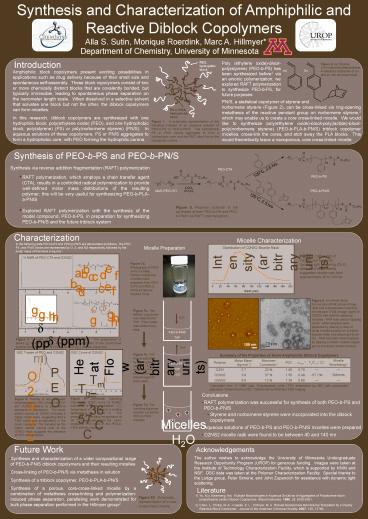Synthesis and Characterization of Amphiphilic and Reactive Diblock Copolymers - PowerPoint PPT Presentation
1 / 1
Title:
Synthesis and Characterization of Amphiphilic and Reactive Diblock Copolymers
Description:
RAFT polymerization, which employs a chain transfer agent (CTA), results in a ... Explored RAFT polymerization with the synthesis of the model compound, PEO-b-PS, ... – PowerPoint PPT presentation
Number of Views:214
Avg rating:3.0/5.0
Title: Synthesis and Characterization of Amphiphilic and Reactive Diblock Copolymers
1
Synthesis and Characterization of Amphiphilic and
Reactive Diblock Copolymers
Alla S. Sutin, Monique Roerdink, Marc A. Hillmyer
Department of Chemistry, University of Minnesota
Introduction
Poly (ethylene oxide)-block-poly(styrene)
(PEO-b-PS) has been synthesized before1 via an
anionic polymerization we explored RAFT
polymerization to synthesize PEO-b-PS, for future
purposes.
Figure 2. (a) Styrene. (b) 4-norbornenylethylsty
rene. A statistical copolymer of (a) and (b) can
be cross-linked.
Amphiphilic block copolymers present exciting
possibilities in applications such as drug
delivery because of their small size and
spontaneous self-assembly. These block
copolymers consist of two or more chemically
distinct blocks that are covalently bonded, but
typically immiscible, leading to spontaneous
phase separation on the nanometer length scale.
When dissolved in a selective solvent that
solvates one block but not the other, the diblock
copolymers can form micelles. In this research,
diblock copolymers are synthesized with one
hydrophilic block, poly(ethylene oxide) (PEO),
and one hydrophobic block, poly(styrene) (PS) or
poly(norbornene styrene) (PN/S). In aqueous
solutions of these copolymers, PS or PN/S
aggregates to form a hydrophobic core, with PEO
forming the hydrophilic corona.
PN/S, a statistical copolymer of styrene
and norbornene styrene (Figure 2), can be
cross-linked via ring-opening metathesis of the
reactive pendant group on norbornene styrene,2
which may enable us to create a core cross-linked
micelle. We would like to synthesize
poly(ethylene oxide)-block-poly(lactide)-block-pol
y(norbornene styrene) (PEO-b-PLA-b-PN/S) triblock
copolymer micelles, cross-link the cores, and
etch away the PLA blocks. This would
theoretically leave a nanoporous, core
cross-linked micelle.
Figure 1. A schematic representation of the
resulting micelles of an aqueous solution of
PEO-b-PS or PEO-b-PN/S. The hydrophobic PS or
PN/S blocks aggregate to form a hydrophobic core
and the PEO block forms the hydrophilic corona.
Synthesis of PEO-b-PS and PEO-b-PN/S
Synthesis via reverse addition fragmentation
(RAFT) polymerization
PEO-CTA
- RAFT polymerization, which employs a chain
transfer agent (CTA), results in a controlled
radical polymerization to provide well-defined
molar mass distributions of the resulting
polymer this will be very useful for
synthesizing PEO-b-PLA-b-PN/S - Explored RAFT polymerization with the synthesis
of the model compound, PEO-b-PS, in preparation
for synthesizing PEO-b-PN/S and the future
triblock system
PEO-b-PS
MeO-PEO-OH
PEO-b-PN/S
Figure 3. Reaction scheme of the synthesis of
both PEO-b-PS and PEO-b-PN/S via RAFT
polymerization.
Characterization
Micelle Characterization
In the following data PEO-b-PS and PEO-b-PN/S are
abbreviated as follows the PEO, PS, and PN/S
blocks are represented by O, S, and NS
respectively, followed by the molar mass of that
block in kg mol-1.
Micelle Preparation
Figure 8. Distribution of micelle radii based on
dynamic light scattering (DLS) data. DLS
experiments suggested micelle radii from
approximately 40 to 140 nm.
Figure 4. 1H NMR of PEO-CTA and PEO-b-PN/S. The
appearance of peaks (g) and (h) (bottom) indicate
the polymerization of the norbornene styrene
monomer onto the PEO-CTA forming a diblock
copolymer.
1Calculated from 1H NMR data. 2Polydispersity
index (PDI) determined by SEC with polystyrene
standards. 3Determined by DSC. 4Determined by AFM
and TEM imaging.
- Conclusions
- RAFT polymerization was successful for synthesis
of both PEO-b-PS and PEO-b-PN/S - Styrene and norbornene styrene were incorporated
into the diblock copolymers - Aqueous solutions of PEO-b-PS and PEO-b-PN/S
micelles were prepared - O2NS2 micelle radii were found to be between 40
and 140 nm
Figure 6. Differential Scanning Calorimetry (DSC)
curve of O2NS2 indicating a glass transition (Tg)
temperature of -57 C and a melting temperature
(Tm) of 36 C. The presence of a melting
temperature at 36 C is associated with the
semi-crystalline PEO block in the PEO-b-PN/S
diblock copolymer.
Figure 5. Overlay of size exclusion
chromatography (SEC) traces of PEO and O2NS2
relative to polystyrene standards in chloroform.
The lower elution volume of O2NS2 indicates a
higher molar mass, suggesting that a PN/S block
was incorporated in the block copolymer. The
shoulder on the higher elution volume side of the
O2NS2 trace suggests the presence of PEO
homopolymer.
Future Work
Acknowledgements
The author wishes to acknowledge the University
of Minnesota Undergraduate Research Opportunity
Program (UROP) for generous funding. Images were
taken at the Institute of Technology
Characterization Facility, which is supported by
NNIN and NSF. DSC data was taken at the Polymer
Characterization Facility. Special thanks to the
Lodge group, Peter Simone, and John Zupancich for
assistance with dynamic light scattering.
- Synthesis and characterization of a wider
compositional range of PEO-b-PN/S diblock
copolymers and their resulting micelles - Cross-linking of PEO-b-PN/S via metathesis in
solution - Synthesis of a triblock copolymer,
PEO-b-PLA-b-PN/S - Synthesis of a porous, core-cross-linked micelle
by a combination of metathesis cross-linking and
polymerization-induced phase separation,
paralleling work demonstrated for bulk phase
separation performed in the Hillmyer group2
Literature
- Yu, Kui Eisenberg, Adi. Multiple Morphologies
in Aqueous Solutions of Aggregates of
Polystyrene-block-poly(ethylene oxide) Diblock
Copolymers. Macromolecules. 1996, 29, 6359-6361. - Chen, L. Phillip, W. A. Cussler, E. L.
Hillmyer, M. A. Robust Nanoporous Membranes
Templated by a Doubly Reactive Block Copolymer.
Journal of the American Chemical Society. 2007,
129, 13786.































